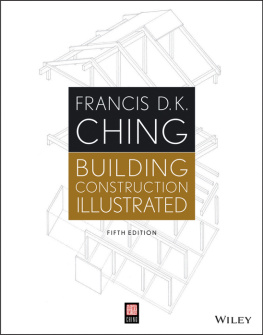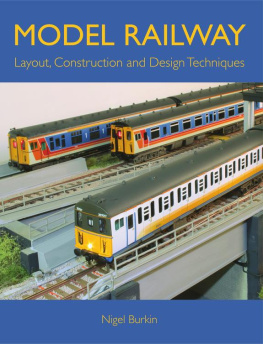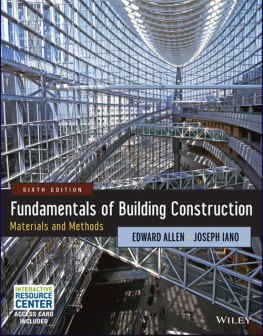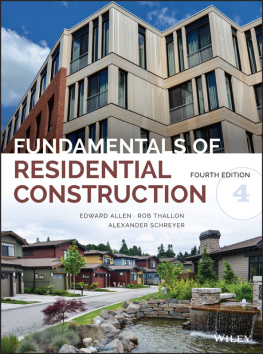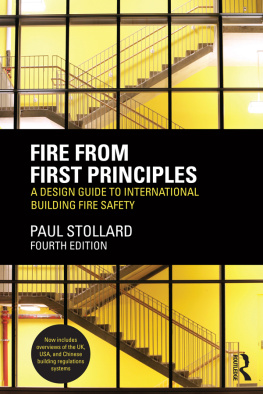
Building Construction
Illustrated
Fifth Edition

Francis D. K. Ching
Copyright 2013 by John Wiley & Sons. All rights reserved
Published by John Wiley & Sons, Inc., Hoboken, New Jersey
Published simultaneously in Canada
No part of this publication may be reproduced, stored in a retrieval system, or transmitted in any form or by any means, electronic, mechanical, photocopying, recording, scanning, or otherwise, except as permitted under Section 107 or 108 of the 1976 United States Copyright Act, without either the prior written permission of the Publisher, or authorization through payment of the appropriate per-copy fee to the Copyright Clearance Center, 222 Rosewood Drive, Danvers, MA 01923, (978) 750-8400, fax (978) 646-8600, or on the web at www.copyright.com. Requests to the Publisher for permission should be addressed to the Permissions Department, John Wiley & Sons, Inc., 111 River Street, Hoboken, NJ 07030, (201) 748-6011, fax (201) 748-6008, or online at www.wiley.com/go/permissions.
Limit of Liability/Disclaimer of Warranty: While the publisher and author have used their best efforts in preparing this book, they make no representations or warranties with the respect to the accuracy or completeness of the contents of this book and specifically disclaim any implied warranties of merchantability or fitness for a particular purpose. No warranty may be created or extended by sales representatives or written sales materials. The advice and strategies contained herein may not be suitable for your situation. You should consult with a professional where appropriate. Neither the publisher nor the author shall be liable for damages arising herefrom.
For general information about our other products and services, please contact our Customer Care Department within the United States at (800) 762-2974, outside the United States at (317) 572-3993 or fax (317) 572-4002.
Wiley publishes in a variety of print and electronic formats and by print-on-demand. Some material included with standard print versions of this book may not be included in e-books or in print-on-demand. If this book refers to media such as a CD or DVD that is not included in the version you purchased, you may download this material at http://booksupport.wiley.com. For more information about Wiley products, visit www.wiley.com.
Library of Congress Cataloging-in-Publication Data:
Ching, Frank, 1943
Building construction illustrated / Francis D. K. Ching. -- Fifth edition.
pages cm
Includes index.
ISBN 978-1-118-45834-1 (pbk.)
1. Building. 2. House construction. I. Title.
TH146.C52 2014
690--dc23
2013016213
Preface
The first edition of this illustrated guide to building construction appeared in 1975, introducing students and builders of architecture to the fundamental principles that govern how buildings are erected. It marked the emergence of a visual approach to understanding the relationship between design and construction.
In 1991, the second edition provided a more expansive survey of building construction by adding coverage of structural steel, reinforced concrete, and curtain wall systems. The third edition in 2001 remained a comprehensive introduction to the principles underlying building construction while refining the graphic format and organization of the first two editions, incorporating an expanded discussion of structural principles, elements, and systems and referencing the Americans with Disabilities Act Accessibility Guidelines and the MasterFormat system established by the Constructions Specifications Institute (CSI) for organizing construction information.
The fourth edition in 2008 introduced the LEED Green Building Rating System in Chapter One and referenced specific LEED criteria wherever appropriate; updated section numbers to correspond to the 2004 edition of the CSI MasterFormat system; and complied with the requirements of the 2006 edition of the International Building Code.
A common thread that wove itself through the first four editions and continues in this fifth edition is the attitude that buildings and sites should be planned and developed in an environmentally sensitive manner, responding to context and climate to reduce their reliance on active environmental control systems and the energy they consume. This edition therefore continues to reference the latest edition of the LEED Green Building Rating System criteria and the section numbers of the 2012 CSI MasterFormat system wherever appropriate. Many of the changes and additions in this fifth edition, such as updating information in lighting technologies and ways in which to reduce energy usage in buildings, are incremental and often subtle, but together they comprise a continuing commitment to build wisely and sustainably.
It would be nearly impossible to cover all building materials and construction techniques, but the information presented herein should be applicable to most residential and commercial construction situations encountered today. Construction techniques continue to adjust to the development of new building materials, products, and standards. What does not change are the fundamental principles that underlie building elements and the ways in which systems are constructed. This illustrated guide focuses on these principles, which can serve as guideposts when evaluating and applying new information encountered in the planning, design, and construction of a building.
Each building element, component, or system is described in terms of its end use. The specific form, quality, capability, and availability of an element or component will vary with manufacturer and locale. It is therefore important to always follow the manufacturers recommendation in the use of a material or product and to pay careful attention to the building code requirements in effect for the use and location of a planned building. It is the users responsibility to ascertain the appropriateness of the information contained in this handbook and to judge its fitness for any particular purpose. Seek the expert advice of a professional when needed.
Metric Equivalents
The International System of Units is an internationally accepted system of coherent physical units, using the meter, kilogram, second, ampere, kelvin, and candela as the base units of length, mass, time, electric current, temperature, and luminous intensity. To acquaint the reader with the International System of Units, metric equivalents are provided throughout this book according to the following conventions:
- All whole numbers in parentheses indicate millimeters unless otherwise noted.
- Dimensions 3 inches and greater are rounded to the nearest multiple of 5 millimeters.
- Nominal dimensions are directly converted; for example, a nominal 2 4 is converted to 51 100 even though its actual 1-" 3-" dimensions would be converted to 38 90.
- Note that 3487 mm = 3.487 m.
- In all other cases, the metric unit of measurement is specified.
- Refer to the Appendix for metric conversion factors.
Chapter 1
THE BUILDING SITE
1.02 BUILDING IN CONTEXT
Buildings do not exist in isolation. They are conceived to house, support, and inspire a range of human activities in response to sociocultural, economic, and political needs, and are erected in natural and built environments that constrain as well as offer opportunities for development. We should therefore carefully consider the contextual forces that a site presents in planning the design and construction of buildings.
Next page
